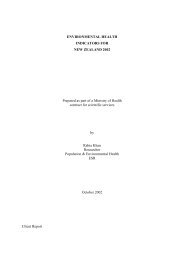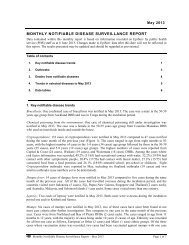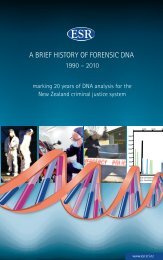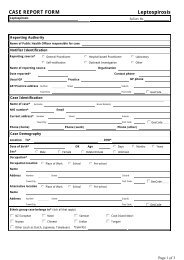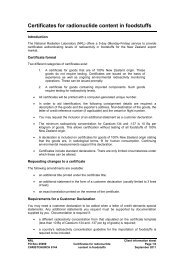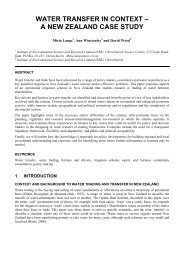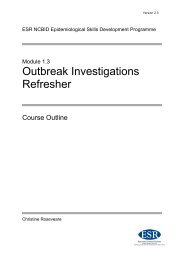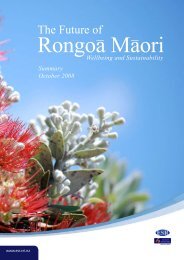Invasive Pneumococcal Disease in New Zealand, 2010
Invasive Pneumococcal Disease in New Zealand, 2010
Invasive Pneumococcal Disease in New Zealand, 2010
You also want an ePaper? Increase the reach of your titles
YUMPU automatically turns print PDFs into web optimized ePapers that Google loves.
3.11 Antimicrobial susceptibilityTable 10 shows the antimicrobial susceptibility of the 514 culture-positive IPD cases <strong>in</strong> <strong>2010</strong>.The penicill<strong>in</strong> and cefotaxime MICs displayed the typical bimodal distribution(Appendix 10).6.0% of isolates had comb<strong>in</strong>ed penicill<strong>in</strong> (men<strong>in</strong>gitis <strong>in</strong>terpretation) and erythromyc<strong>in</strong>resistance, and 1.0% had comb<strong>in</strong>ed penicill<strong>in</strong>-<strong>in</strong>termediate resistance (non-men<strong>in</strong>gitis<strong>in</strong>terpretation) and erythromyc<strong>in</strong> resistance. Among the penicill<strong>in</strong>-resistant isolates(men<strong>in</strong>gitis <strong>in</strong>terpretation), 30.1% (28/93) were multiresistant to 3 additional antibiotics,commonly co-trimoxazole, erythromyc<strong>in</strong> and tetracycl<strong>in</strong>e with or without cefotaximeresistance.Table 10. Antimicrobial susceptibility among isolates from <strong>in</strong>vasive pneumococcaldisease cases, <strong>2010</strong>Interpretive standardsS 1 I 1 R 1PercentMIC (mg/L) S I Rpenicill<strong>in</strong>men<strong>in</strong>gitis ≤0.06 - ≥0.12 81.9 - 18.1non-men<strong>in</strong>gitis ≤2 4 ≥8 99.0 1.0 0.0oral treatment ≤0.06 0.12-1 ≥2 81.9 12.1 6.0cefotaximemen<strong>in</strong>gitis ≤0.5 1 ≥2 91.8 6.2 1.9non-men<strong>in</strong>gitis ≤1 2 ≥4 98.1 0.4 1.6Zone diameter (mm)chloramphenicol ≥21 - ≤20 98.1 - 2.0cl<strong>in</strong>damyc<strong>in</strong> 2 ≥19 16-18 ≤15 94.8 0.2 5.1co-trimoxazole ≥19 16-18 ≤15 73.5 2.1 24.3erythromyc<strong>in</strong> ≥21 16-20 ≤15 91.1 0.0 9.0moxifloxac<strong>in</strong> ≥18 15-17 ≤14 99.8 0.2 0.0rifampic<strong>in</strong> ≥19 17-18 ≤16 100.0 0.0 0.0tetracycl<strong>in</strong>e ≥23 19-22 ≤18 91.6 0.8 7.6vancomyc<strong>in</strong> ≥17 - - 100.0 - -1 S, susceptible; I, <strong>in</strong>termediate; R, resistant.2 The percentage resistant given is for constitutive cl<strong>in</strong>damyc<strong>in</strong> resistance. One further isolate (0.2%) had<strong>in</strong>ducible cl<strong>in</strong>damyc<strong>in</strong> resistance.Trends <strong>in</strong> penicill<strong>in</strong> and cefotaxime resistance and multidrug resistance for the last 10 years(2001-<strong>2010</strong>) are shown <strong>in</strong> Appendix 11. Both penicill<strong>in</strong> and cefotaxime resistance, based onthe men<strong>in</strong>gitis <strong>in</strong>terpretive standards, decreased between 2008 and 2009 after the <strong>in</strong>troductionof PCV-7 <strong>in</strong> 2008, but there was no further decrease <strong>in</strong> resistance to either antibiotic between2009 and <strong>2010</strong>.<strong>Invasive</strong> pneumococcal disease 19 September 2011<strong>in</strong> NZ, <strong>2010</strong>




